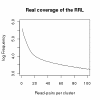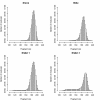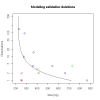Structural variation in the chicken genome identified by paired-end next-generation DNA sequencing of reduced representation libraries
- PMID: 21291514
- PMCID: PMC3039614
- DOI: 10.1186/1471-2164-12-94
Structural variation in the chicken genome identified by paired-end next-generation DNA sequencing of reduced representation libraries
Abstract
Background: Variation within individual genomes ranges from single nucleotide polymorphisms (SNPs) to kilobase, and even megabase, sized structural variants (SVs), such as deletions, insertions, inversions, and more complex rearrangements. Although much is known about the extent of SVs in humans and mice, species in which they exert significant effects on phenotypes, very little is known about the extent of SVs in the 2.5-times smaller and less repetitive genome of the chicken.
Results: We identified hundreds of shared and divergent SVs in four commercial chicken lines relative to the reference chicken genome. The majority of SVs were found in intronic and intergenic regions, and we also found SVs in the coding regions. To identify the SVs, we combined high-throughput short read paired-end sequencing of genomic reduced representation libraries (RRLs) of pooled samples from 25 individuals and computational mapping of DNA sequences from a reference genome.
Conclusion: We provide a first glimpse of the high abundance of small structural genomic variations in the chicken. Extrapolating our results, we estimate that there are thousands of rearrangements in the chicken genome, the majority of which are located in non-coding regions. We observed that structural variation contributes to genetic differentiation among current domesticated chicken breeds and the Red Jungle Fowl. We expect that, because of their high abundance, SVs might explain phenotypic differences and play a role in the evolution of the chicken genome. Finally, our study exemplifies an efficient and cost-effective approach for identifying structural variation in sequenced genomes.
Figures








Similar articles
-
Geographic distribution and adaptive significance of genomic structural variants: an anthropological genetics perspective.Hum Biol. 2014 Fall;86(4):260-75. doi: 10.13110/humanbiology.86.4.0260. Hum Biol. 2014. PMID: 25959693 Review.
-
Paired-end mapping reveals extensive structural variation in the human genome.Science. 2007 Oct 19;318(5849):420-6. doi: 10.1126/science.1149504. Epub 2007 Sep 27. Science. 2007. PMID: 17901297 Free PMC article.
-
Long span DNA paired-end-tag (DNA-PET) sequencing strategy for the interrogation of genomic structural mutations and fusion-point-guided reconstruction of amplicons.PLoS One. 2012;7(9):e46152. doi: 10.1371/journal.pone.0046152. Epub 2012 Sep 28. PLoS One. 2012. PMID: 23029419 Free PMC article.
-
Comprehensive long-span paired-end-tag mapping reveals characteristic patterns of structural variations in epithelial cancer genomes.Genome Res. 2011 May;21(5):665-75. doi: 10.1101/gr.113555.110. Epub 2011 Apr 5. Genome Res. 2011. PMID: 21467267 Free PMC article.
-
A Practical Guide for Structural Variation Detection in the Human Genome.Curr Protoc Hum Genet. 2020 Sep;107(1):e103. doi: 10.1002/cphg.103. Curr Protoc Hum Genet. 2020. PMID: 32813322 Free PMC article. Review.
Cited by
-
Genome-wide patterns of genetic variation in two domestic chickens.Genome Biol Evol. 2013;5(7):1376-92. doi: 10.1093/gbe/evt097. Genome Biol Evol. 2013. PMID: 23814129 Free PMC article.
-
Genome Wide Identification of Structure Variations in Five Italian Turkey Populations.Animals (Basel). 2025 Jan 24;15(3):339. doi: 10.3390/ani15030339. Animals (Basel). 2025. PMID: 39943109 Free PMC article.
-
Generation of SNP datasets for orangutan population genomics using improved reduced-representation sequencing and direct comparisons of SNP calling algorithms.BMC Genomics. 2014 Jan 10;15:16. doi: 10.1186/1471-2164-15-16. BMC Genomics. 2014. PMID: 24405840 Free PMC article.
-
The Chicken Pan-Genome Reveals Gene Content Variation and a Promoter Region Deletion in IGF2BP1 Affecting Body Size.Mol Biol Evol. 2021 Oct 27;38(11):5066-5081. doi: 10.1093/molbev/msab231. Mol Biol Evol. 2021. PMID: 34329477 Free PMC article.
-
An Efficient Genotyping Method in Chicken Based on Genome Reducing and Sequencing.PLoS One. 2015 Aug 27;10(8):e0137010. doi: 10.1371/journal.pone.0137010. eCollection 2015. PLoS One. 2015. PMID: 26313744 Free PMC article.
References
-
- McKernan KJ, Peckham HE, Costa G, McLaughlin S, Tsung E, Fu Y, Clouser C, Dunkan C, Ichikawa J, Lee C, Zhang Z, Sheridan A, Fu H, Ranade S, Dimilanta E, Sokolsky T, Zhang L, Hendrickson C, Li B, Kotler L, Stuart J, Malek J, Manning J, Antipova A, Perez D, Moore M, Hayashibara K, Lyons M, Beaudoin R, Coleman B, Laptewicz M, Sanicandro A, Rhodes M, Vega FDL, Gottimukkala RK, Hyland F, Reese M, Yang S, Bafna V, Bashir A, Macbride A, Aklan C, Kidd JM, Eichler EE, Blanchard AP. Sequence and structural variation in a human genome uncovered by short-read, massively parallel ligation sequencing using two base encoding. Genome Res. 2009;19:1527–1541. doi: 10.1101/gr.091868.109. - DOI - PMC - PubMed
-
- Korbel JO, Urban AE, Affourtit JP, Godwin B, Grubert F, Simons JF, Kim PM, Palejev D, Carriero NJ, Du L, Taillon BE, Chen Z, Tanzer A, Saunders ACE, Chi J, Yang F, Carter NP, Hurles ME, Weissman SM, Harkins TT, Gerstein MB, Egholm M, Snyder M. Paired-end mapping reveals extensive structural variation in the human genome. Science. 2007;318:420–426. doi: 10.1126/science.1149504. - DOI - PMC - PubMed
-
- Kidd JM, Cooper GM, Donahue WF, Hayden HS, Sampas N, Graves T, Hansen N, Teague B, Alkan C, Antonacci F, Haugen E, Zerr T, Yamada NA, Tsang P, Newman TL, Tüzün E, Cheng Z, Ebling HM, Tusneem N, David R, Gillett W, Phelps KA, Weaver M, Saranga D, Brand A, Tao W, Gustafson E, McKernan K, Chen L, Malig M, Smith JD, Korn JM, McCarroll SA, Altshuler DA, Peiffer DA, Dorschner M, Stamatoyannopoulos J, Schwartz D, Nickerson DA, Mullikin JC, Wilson RK, Bruhn L, Olson MV, Kaul R, Smith DR, Eichler EE. Mapping and sequencing of structural variation from eight human genomes. Nature. 2008;453:56–64. doi: 10.1038/nature06862. - DOI - PMC - PubMed
Publication types
MeSH terms
LinkOut - more resources
Full Text Sources
Other Literature Sources

